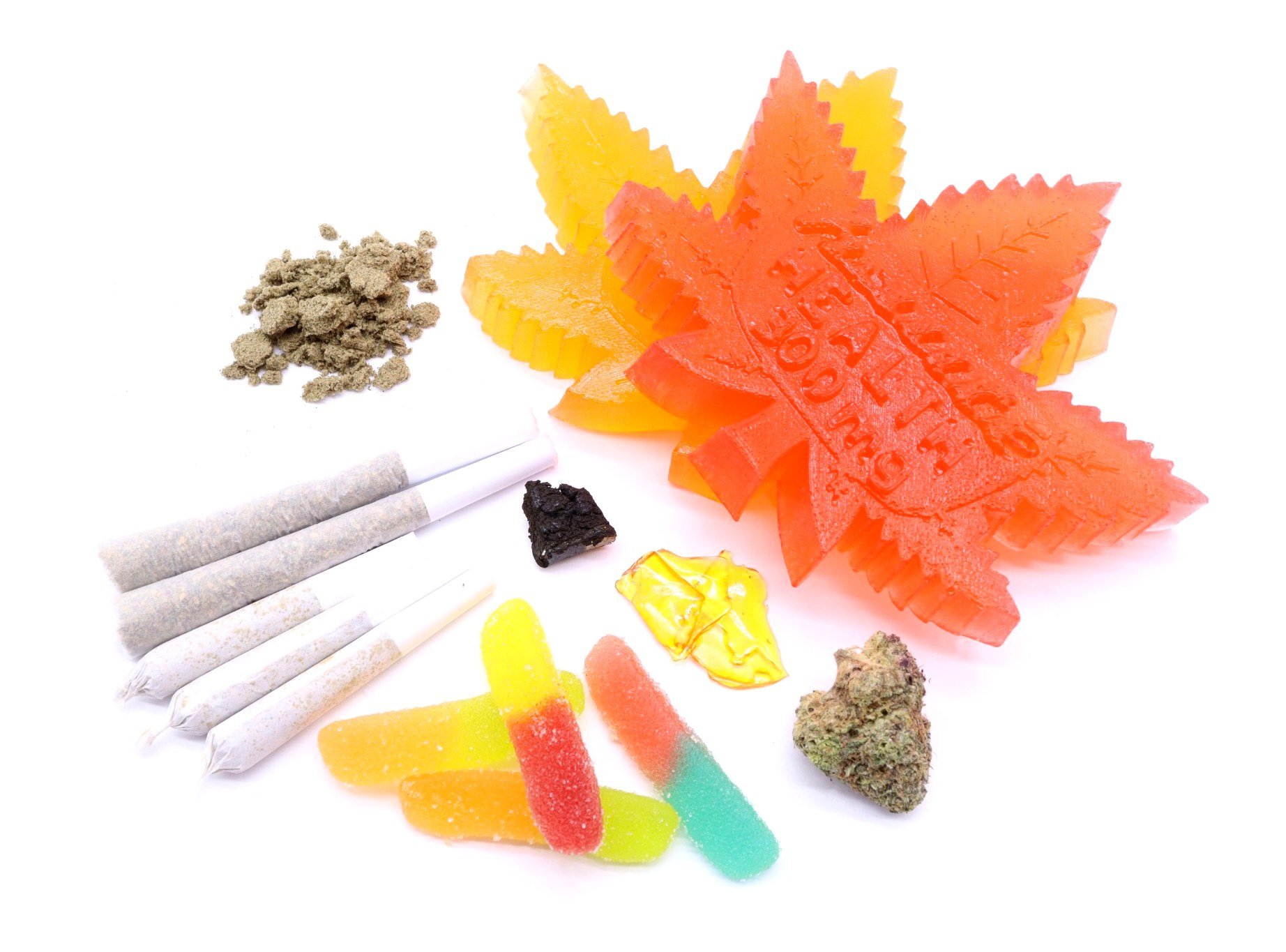We have extracted a lot out of cannabis in the last few decades. The amount of cannabinoids and now terpenes we’ve managed to extract from all the varieties of cannabis has led to a revolution in cannabis concentrates & extracts. Since the early 2000’s dedicated growers and product manufacturers have explored new & exciting ways to get the most out of our pot plants. These improvements in extraction technology has resulted in a boom for cannabis extracts, especially when it comes to high terpene resins and high terpene extracts.
What does it mean to be a high terpene extract or high terpene resin? Is it easy to learn how to make HTFSE extracts at home? How do you use full-spectrum oils to your benefit? For that matter, what the heck is an HTFSE?! We’ll extract all the knowledge of high terpene, full-spectrum extracts and deliver a healthy dose of cannabis know-how in this in-depth guide to high terpene extracts.
What Is HTFSE?
HTFSE isn’t a name that inspires stoners, is it? Sounds more like another kind of HVAC or new operating system for your iPhone. What if instead we told you all about high-terpene full-spectrum extracts? HTFSE’s, otherwise known as full-spectrum, high terpene extracts are a purist formulation of cannabis concentrate that focuses on maximizing quality. Whether you’re after a flavorful experience, an aromatic adventure, or want to get so high that you forget what either of those concepts means then HTFSE’s and other high terpene resins are perfect for you.
We’ll discuss how to make HTFSE extracts and even go over how you use full spectrum hash oils, but first we need to further explore the definition for what is an HTFSE. Just saying “high terpene full-spectrum extract” doesn’t mean much to some stoners; for others, it hints at a world of wholesome cannabis juices that make their mouths water.
There are typically two kinds of high-potency, full-spectrum extracts: HTFSE’s and HCFSE’s. HCFSE stands for ‘High Cannabinoid Full-Spectrum Extracts’ and is a concentration of all the resident cannabinoids from a plant, extracted in a way that preserves their collective phytocompounds. High-terpene full-spectrum extracts are the exact same, but they simply hone in on the terpenoid contents of a cannabis cultivar.
If you don’t know the differences between cannabinoids and terpenes, here’s a really brief breakdown. We’d definitely recommend reading a few of our other guides to cannabinoids like CBN, terpenes & flavonoids or the benefits of hybrid cannabis vs balanced cannabis:
CANNABINOIDS
Phytocannabinoids, referred to as cannabinoids by most, are plant-based compounds that are the main drivers for influences on our minds & bodies. Think of cannabinoids like THC, CBD, CBN, CBG and hundreds more as the active compounds that cause us to feel high, tired, hungry, sleepy, giddy or energized.
Keep in mind that in the recent past not a lot was known about terpenes, therefore cannabinoids received all the credit for cannabis’ mind-altering effects and its positive influences on human health. Today, we know that terpenes play a major role in-tandem with cannabinoids like THC & CBD, so if you’re used to thinking of cannabinoids as the “drivers” for the effects of cannabis try to shift this thinking to more of a “co-pilot” scenario alongside terpenes.
Currently, there are 113 distinct phytocannabinoids that have been identified by researchers, with the possibility for much more yet to be mapped out. Some examples of cannabinoids are:
THC, CBD, CBN, CBG, CBC, THCV, CBGV, etc.
TERPENES
Terpenoids or terpenes have a lot more mysteries surrounding them, despite the fact that research into these particular compounds has skyrocketed in recent years. These naturally occurring compounds exist in many other fruiting & flowering plants, but what were thought to be just biochemical signatures for flavors/aromas have been discovered to have their own impacts on how cannabis makes you feel.
Terpenes are a major part of what shapes your cannabis experience – they can produce certain flavors like citrus or fuel, emit aromas like lavender or spice, and contribute to your high, relaxation or mental acuity while under the influences of cannabis. Certain terpenes have certain effects, such as the relaxing feelings of myrcene or the uplifting influences from terpinolene. Terpenes demonstrate a lot more consistency in their effects than cannabinoids – many people can experience different effects due to their unique, endocannabinoid system’s tolerances.
There are 150+ terpenes that have been discovered in cannabis to-date, but researchers suggest there could be more yet to be isolated. Terpene contents will vary from cultivar to strain, but the most well-known or commonly sought-after terpenes are:
Limonene, Pinene, Myrcene, Linalool, Caryophyllene, Terpineol, Humulene and Terpinolene
Another concept we need to consider has to do with the combinations, synergies and cooperative factors of cannabinoids and terpenes: Full-Spectrum cannabis products and the Entourage Effect:
FULL-SPECTRUM
Full-spectrum cannabis extractions are exactly that – the entire spectrum of active plant compounds. Many cannabis and hemp products are isolate forms of cannabinoids – i.e. THC only or CBD only products. These kinds of isolate extracts are great if you’ve got a particular dosage or usage for cannabis, but you might not be getting the most out of your cannabis by focusing on one particular cannabinoid or terpene.
Full-spectrum products utilize the entire offering of phytocompounds in order to benefit from something called ‘the entourage effect’…
THE ENTOURAGE EFFECT
The entourage effect is the concept of benefitting from all the resident plant compounds together – i.e. the sum of the whole is greater than the individual parts. This theory has a lot of scientific backing as well – many cannabinoids and terpenes interact with one another to boost positive effects, increase duration or provide a more balanced experience than if they were ingested/absorbed individually.
This is not to suggest that many singular or dual formulation products aren’t as effective – it all depends what you’re using cannabis for, what your tolerance levels are and how frequent you plan on consuming marijuana. Full-spectrum products offer the benefits of cannabinoids & terpenes working in-conjunction with one another to potentially achieve a more natural, potent and positive experience.
How To Make HTFSE Extract
Now that we understand what is HTFSE made up of, we can learn more about the process of how it is extracted, prepared and why high terpene extracts and resins are so valuable on the market today.
High terpene resins and certain cannabis genetics that are renowned for their cannabinoids potencies make the best HTFSE’s. In a way, it doesn’t matter how you grow, how you extract or the final processing/storing techniques if you’re dealing with some bunk buds. Genetics are a major part of what sets up a grower to be able to cultivate a vibrant, potent pot plant. It still takes a lot of skills & knowledge from the growers, harvesters and processors, but it needs to be stated how integral genetics are learning how to make HTFSE extracts.
HTFSE typically contain between 45-50% cannabinoids and 15-40% terpenes. These potency factors aren’t a necessity for all HTFSE’s, but anything significantly less might not be considered a high terpene extract. One of the most important steps to producing a high terpene resin that can be rendered into various cannabis concentrate products has to do with how the buds are stored. We’ll start with flower storage, then continue onto extraction, separation, purging and then final processing:
STORAGE
Flash frozen buds are the typical source for extraction, but expert dryers/curers can sometimes avoid using freezing temperatures before the actual extraction process occurs. The trick to storing cannabis flowers is to maintain freshness and potency of the terpenes, which means they can’t be stored for too long. Flash-freezing buds is safe, but a small loss of terpenoids can occur, which is why many high terpene resin purists prefer to do it all with the freshest buds they can get.
EXTRACTION
Extraction used to require organic solvents and risked a lot of flammability or toxicity from solvents like butane. Today, most extractors utilize the safe and easy-to-manage CO2 extraction methods. Another popular way to extract high terpene resins is through the aforementioned ‘flash frozen’ or ice bucket method.
SEPARATION
Next, the most simple of the steps doesn’t involve much – just store your extracted compounds in a relatively cool, dark environment to allow the terpenes the chance to separate from the plant resins and oils. This process will lead the active compounds of cannabinoids and terpenes to crystallize, making them easier to isolate from the rest of the solution.
PURGING
One of the final steps is very important and can often be overlooked. Even if you’re using safer solvents like CO2, it is imperative that you purge the residual chemicals or gasses from the extracts. This can be done through heat and pressure, or sometimes a mechanical stirring methodology is used.
PROCESSING
Last but not least, high terpene extracts need to be processed or finished in a way that locks in their active terpenoids or cannabinoids, typically in a sauce, liquid/oil form or even served in chunks of resin.
Learning how to make HTFSE extracts is definitely not for beginners – growing high-potency weed on top of all the technical know-how required for extraction & processing can take years and years to perfect. Still, it’s a rewarding project that many experienced stoners take on in their later years, or as their appetites for pure, potent cannabis continues to develop.
How Do You Use Full-Spectrum Oil?
One of the easiest answers to how do you use full-spectrum hash oils is to simply suggest “however you like”. Many extracts-nerds love to dab high terpene resins, some prefer to smoke sauce the good old fashioned way, while others still mix it in or garnish edibles with these high-potency extracts. The only things you need to consider when you’re deciding how to use full-spectrum oils are:
1. Why are you consuming high terpene full-spectrum extracts?
2. How long/how frequent will you be consuming them?
First off, the reasons why you’re consuming HTFSE’s will go a long way towards determining point #2. If you’re just a sucker for some tasty, powerful extracts then there’s no pressure on how much, or how often you consume HTFSE’s. On the other hand, people with severe medical needs for cannabis will undoubtedly rely on consistent potencies, doses and effects from their high terpene extracts.
High terpene or high cannabinoid sauces can be stored for later, but the longer you wait the less potent they become. These kinds of high terpene extracts are meant to be consumed fresh, or as close to fresh as possible. This guarantees the most powerful terpenoid experiences, flavors, aromas, effects and more. If maximizing potency or sensory experiences isn’t top-of-mind for you, then you can get away with stretching the shelf-life of your HTFSE’s.
Lastly, it’s always a good idea to keep experimenting with cannabis concentrates and extracts. As much as most of the product online are made with quality in mind, some are not equal to others. This might be due to genetics, cultivation, processing or storage practices – the line between good and bad products can be very thin at times.
Always try new types of extracts, explore new potency levels and experiment with all sorts of terpene profiles and full-spectrums of cannabinoids. This is the path to finding the cannabis that suits your health the best. Just like we are all unique, complex individuals, cannabis strains are multifaceted and diverse beyond our feeble human comprehension. So, keep trying new high terpene extracts & high cannabinoid concentrates in the never ending quest for that ‘perfect pot’.


